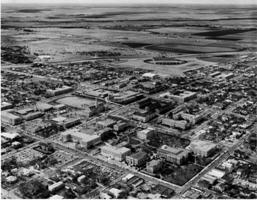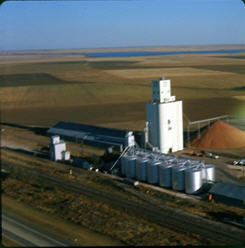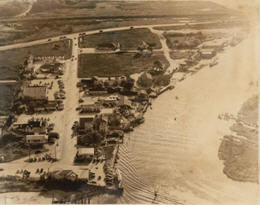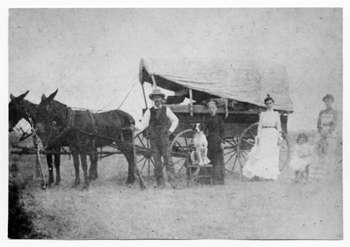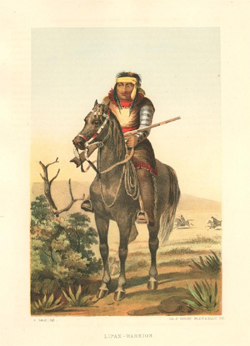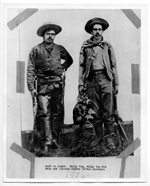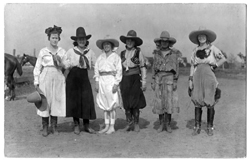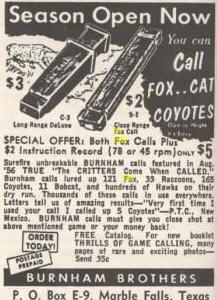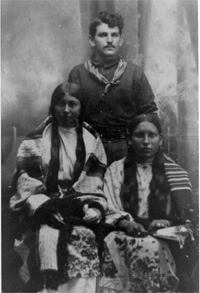Content
New Collections
What's in the lab now?
Focus on . . .
Working with Private Collectors
Making a Difference with Students
Iogene Project
Texas Digital Newspaper Program
UNT Digital Collections

Excursion Party at Sharyland, 1920, University of Texas-Pan American
![]()
Fantastic images from Heritage House Museum in Orange
The Heritage House Museum in Orange, Texas has provided over 1,700 photographs to the Portal to Texas History depicting life, 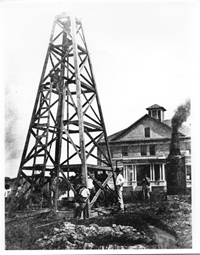 nature, and industry in the Orange area from the late nineteenth century through modern times. Orange was an important area for lumber, oil, and shipbuilding in the early 20th century. There was a booming oilfield in Orangefield prior to 1920, a US Naval base in the 1940s-60s, numerous shipbuilding companies from the 1950s through the present and chemical plants such as DuPont along "Chemical Row." The image on the right is of an oil derrick in Orangefield.
nature, and industry in the Orange area from the late nineteenth century through modern times. Orange was an important area for lumber, oil, and shipbuilding in the early 20th century. There was a booming oilfield in Orangefield prior to 1920, a US Naval base in the 1940s-60s, numerous shipbuilding companies from the 1950s through the present and chemical plants such as DuPont along "Chemical Row." The image on the right is of an oil derrick in Orangefield.
This collection included photos of the many historic homes,churches, businesses, and people from the area including the Stark mansion, the Link 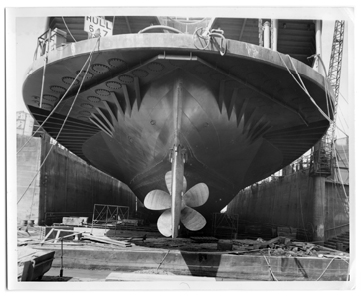 home, First Presbyterian Church (also known as Lutcher Memorial), and Pinehurst Ranch. Also included are current attractions such as the Stark Museum and the Lutcher Theater. In this image we see the ferryboat "John F. Kennedy" under construction in 1965.
home, First Presbyterian Church (also known as Lutcher Memorial), and Pinehurst Ranch. Also included are current attractions such as the Stark Museum and the Lutcher Theater. In this image we see the ferryboat "John F. Kennedy" under construction in 1965.
The Sabine River, along with the bayous and forests that provide natural beauty and attract wildlife to the area can also be seen in thecollection. Many thanks to the Summerlee Foundation, the Stark Foundation, and private contributors who sponsored this project.
The Texas Reports
The Portal to Texas History has added 67 volumes of the Texas Reports. These contain decisions of the Supreme Court of the State of Texas beginning in 1846. The decisions are fascinating not only from a legal standpoint, but also because they provide a vibrant view of Texas's culture and politics throughout its history as a part of the United States and the Confederate States of America. Of special interest are the Reconstruction-era volumes which illuminate changes in the Court under the unpopular Constitution of 1869.
Read court decisions about cases of theft, forgery, counterfeiting, murder, divorce, deception, adultery, arson, and even patent infringement! Materials in this and all collections can be browsed by subject, by contributor, by location, and by historical era.
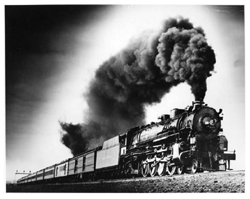 Museum of the American Railroad
Museum of the American Railroad
The collection from the Museum of the American Railroad goes beyond our Texas borders. Included in this fabulous collection are 338 images of trains such as the Texas Eagle, the Texas Special, the Sunshine Special, the Katy Flyer, the Texas Zephyr, the Cannon Ball, the Louisiana Limited and the Texas Chief, to name a few of the Texas trains. Also included are interior 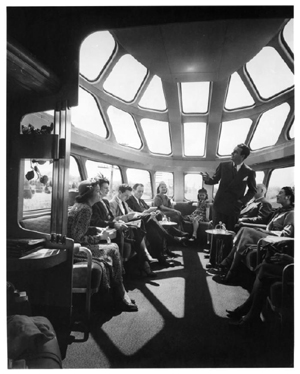 and exterior pictures of depots across America in places such as Albuquerque, Amarillo, Durango, Clovis, Los Angeles, Dearborn, Chicago, Penn Station, and others. Some interior shots show the observation cars and dining cars with their "modern" decor.
and exterior pictures of depots across America in places such as Albuquerque, Amarillo, Durango, Clovis, Los Angeles, Dearborn, Chicago, Penn Station, and others. Some interior shots show the observation cars and dining cars with their "modern" decor.
Those of you who enjoy and remember traveling America's railways will enjoy browsing through this collection.
STIRPES
Stirpes is the quarterly newsletter of the Texas State Genealogical Society, whose purpose "is to stimulate and support research and teaching on the genealogical aspects of history." Last year, the Portal team added back issues of Stirpes from 1961-1990. The lab is currently working to add issues from 1991-2000.
Stirpes includes wonderful information for genealogists, such as extracts of vital statistics from The Telegraph and Texas Register, and information on early Austin county families. Search Stirpes.
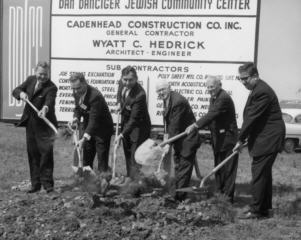 Fort Worth Jewish Archives
Fort Worth Jewish Archives
Working with historian and author Hollace Ava Weiner, we selected photographs and rare materials that document Jewish life in Fort Worth with historical items from Temple Beth-El and Congregation Ahavath Sholom. In this photo, six men in suits dig shovels into the dirt at the groundbreaking of the Dan Danciger Jewish Community Center in 1964.
Log Cabin Village
Log Cabin Village is a living history museum nestled within the  towering oak forest located adjacent to S. University Drive in Fort Worth across from the zoo. The Log Cabin Village collections feature 19th century photographs of the Tompkins, Pickard, Parker, Howard, and Foster families, including tintypes and daguerreotypes. We're also working on digitizing two collections of letters that include correspondence between the Parker and Howard families dating from 1840 to 1940.
towering oak forest located adjacent to S. University Drive in Fort Worth across from the zoo. The Log Cabin Village collections feature 19th century photographs of the Tompkins, Pickard, Parker, Howard, and Foster families, including tintypes and daguerreotypes. We're also working on digitizing two collections of letters that include correspondence between the Parker and Howard families dating from 1840 to 1940.
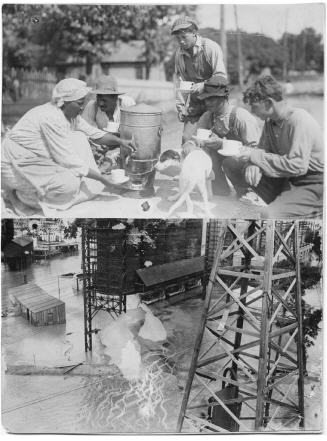 University of Texas at Arlington
University of Texas at Arlington
The Amon Carter Foundation and the Adeline & George McQueen Foundation are providing funding for "Where the West Begins: Capturing Fort Worth's Historic Treasures." Another partner for that effort is UTA. The UTA Special Collections Library offers in-depth resources which portray the rich history of Fort Worth through extensive collections of manuscripts, photographs, books, drawings, letters and maps. UTA holds over 2.7 million images in the photographic archive of the Fort Worth Star Telegram. As part of the project, we are also scanning 21 rare books that focus on Fort Worth History, such as Tarrant County Heroes in the World War (1918); Photographs of Fort Worth (1890); and The Texas Spring Palace (1890). The photo above shows scenes from the devastating flood of 1916.
|
|
Meet Jerrell Jones, an undergraduate student who has been working with us in the digital projects lab since spring of '07. Jerrell is majoring in Photography and will be graduating in December of this year.
Jerrell says, "While working at the DPU 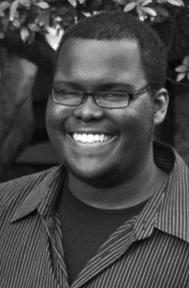 Lab, I have learned a lot of exciting methods in digital imaging technology on top of the knowledge I have gained on my own and in school. I am very fortunate to have the opportunity to gain this knowledge while preserving the past. I have gained a better understanding of why the Portal to Texas History is special and why what we do as student assistants is so important. To scan one book in the lab is almost like a needle in a haystack, but saving a book before it falls apart could make a difference in someone's life."
Lab, I have learned a lot of exciting methods in digital imaging technology on top of the knowledge I have gained on my own and in school. I am very fortunate to have the opportunity to gain this knowledge while preserving the past. I have gained a better understanding of why the Portal to Texas History is special and why what we do as student assistants is so important. To scan one book in the lab is almost like a needle in a haystack, but saving a book before it falls apart could make a difference in someone's life."
"When I am correcting my photographs for printing, I often use knowledge that I have learned from Digital Projects. It's also nice when I can share what I have learned while working at the lab with fellow photographers and other artists."
Jerrell calls Houston home, and says, " What I miss most about Houston is the Arts District. I attended the High School for the Performing and Visual Arts in Houston which was very close to the Museum of Fine Arts, Contemporary Arts Museum and other smaller museums and multiple galleries. Art was always there growing up. There are so many individuals there that contribute so much of their time to young artists, and being one of those artists makes me thankful to come from a place like Houston." Jerrell chose UNT because of the strong programs at the College of Visual Arts, and specifically the Photography program.
"The Photography program has provided me with a series of challenges that have taught me about my craft, myself, those who have challenged me and why they did. With Denton being near both Dallas and Fort Worth, there are so many opportunities for artists of all kinds to come together and share with each other. This is something that I really enjoy about going to UNT and living in this area. What I have loved most about going to UNT is seeing how students support each other in their areas of study. UNT has a large student body, but I have never felt like a number. Through the faculty, campus employees, and students there is a wonderful energy that makes this place home. I am proud to say that I am a North Texan."
Jerrell continues to do a fantastic job working for us while he is earning his degree. UNT is a student-centered public research university, and the Digital Projects Unit is proud to offer rewarding work experiences to so many of our wonderful students.
The Portal team has worked with many private collectors over the years to provide free online access to historic treasures that would otherwise never be available to most people.
 Private Collection of Caroline R. Scrivner Richards
Private Collection of Caroline R. Scrivner Richards
The Private Collection of Caroline R. Scrivner Richards includes letters and photographs predominantly from Paris, Texas. Materials include photographs of family members, the Paris fire of 1916, and family correspondence. Letters also include correspondence between Judge David H. Scott of Paris and family friend Cyrus I. Scofield, author of the Scofield Reference Bible. When the Paris fire broke out in 1916, Mrs. Richard's father Phillip Scrivner was just thirteen years old. He spent three long days separated from the rest of the family, but managed to save the clean clothing from their clothesline! He put it in a laundry basket and carried it in front of him while he rode around Paris on horseback looking for his family. At night he slept on the clean clothes. When he was finally reunited with his family, they realized that they had lost everything except the clothes on their backs and those in the laundry basket.
Grants update: the IOGENE project
While developing and writing the grant for the IOGENE Project, the Portal team uncovered some revealing facts. Almost all of the user-needs research done in the digital library field focused on academic use by scholars, faculty, or students; or K-12 use by teachers and students. One large segment of avid digital library users remained virtually unexamined -- genealogists.
Genealogy has emerged as one of the most popular forms of life-long learning, but almost no research has explored genealogists' information seeking behavior, or how that behavior might inform the design of a digital library interface. This is amazing when you consider that the Pew Internet & American Life Project has found that nearly a quarter of all Internet users seek genealogy information on the Internet. This represents a group of over 50 million Americans.
This winter, the UNT Libraries began work on the grant, the IOGENE Project, a.k.a., Interface Optimization for Genealogists. This $448,000 grant from the Institute for Museum and Library Services will identify the user interface requirements of genealogists interacting with the Portal to Texas History. The IOGENE project will identify a model for digital library interface development using a user-centered design approach. Visit the IOGENE website to learn more about the latest news about this exciting project.

Texas Digital Newspaper Program. We have been approached by many, many libraries interested in providing online access to their local historic newspapers. With all the historic news events that have happened in our great state we are convinced that this is an important area to include on the Portal to Texas History. So we are moving forward with a plan to do just that.
After becoming familiar with newspaper digitization through our work with the National Digital Newspaper Program, we are happy to announce the Texas Digital Newspaper Program as a means to digitize and provide access to many more Texas newspaper titles than we are able to do in the national program alone.
We are actively seeking partnerships with others to digitize Texas's historic newspapers. Our goal is to create a digitized newspaper resource that covers a broad geographical area, and this will only be possible through cooperation and multiple funding sources. This program will follow the same high standards set forth by the Library of Congress for the national program. For more information about the process, standards, funding opportunities, and other FAQs, please visit our Texas Digital Newspaper Program website.

The A to Z Project
In 2007, the Government Documents Department began an ambitious project to digitize those federal documents in its  collections published prior to 1960. As a Federal Depository Library, UNT holds a national reputation for its leadership in providing online access to government information. The “A to Z Digitization Project” intends to provide access to a minimum of 500 additional documents every year.
collections published prior to 1960. As a Federal Depository Library, UNT holds a national reputation for its leadership in providing online access to government information. The “A to Z Digitization Project” intends to provide access to a minimum of 500 additional documents every year.
The first documents digitized come from the U.S. Department of Agriculture. These vintage pamphlets provide advice on raising livestock, pest control, food preparation, and a wide variety of other topics.
Some of the over 350 documents already online include: Rabbit Recipes, Porcupine Control in Western States, Soybeans for the Table, Dairy Cattle Judging, Christmas Trees as a Cash Crop for the Farm, Farm Poultry Raising, Mule Production, Home Tanning of Leather, Chinchilla Raising, Ginning Cotton. Peanut Growing, Rammed Earth Walls for Buildings, Breeds of Dogs, Blueberries, Culture of Orchids, Eliminating Bats from Buildings, and the ironic Kudzu: a Forage Crop for the Southeast.
In 2008, the focus will be on the War Department Technical Manuals from the early twentieth century, since there is a high volume of requests for these.
Help us spread the word and please forward this newsletter to anyone you think will be interested.
|
Check out the new materials online from the Wolf Creek Heritage Museum in Lipscomb, Texas, located in the far northeast corner of the Panhandle. |
There are many ways to help the Portal to Texas History grow. Every gift makes a difference and is a solid investment in preserving and providing access to Texas history. Wish List
|
Hot Comments "The Texas History Portal is such a great resource. My Texas history teachers love it. I use the Texas History notebook for great lessons in the library. My students learn so much more, besides just reading the textbook. Thanks for providing such a great resource to teachers and librarians." - Jennifer Witherspoon, Librarian, Azle ISD 
"We are very excited about the outstanding lessons on your site and plan to use it as one of the cornerstones of implementing a long needed overhaul on the method of instruction for Texas history. - Daniel M. Reyes, Social Studies Teacher Specialist, San Antonio ISD |
Image of the month This great image is a hand-colored stone lithograph of a West Lipan Apache warrior sitting astride a horse and carrying a rifle. This was published in Emory's United States and Mexican Boundary Survey, Washington, 1857. This is just one image from thousands that we have from our wonderful partners at the Star of the Republic Museum, in Washington, Texas. |
| Mission
Statement The Portal to Texas History offers students and lifetime learners a digital gateway to the rich collections held in Texas libraries, museums, archives, historical societies and private collections. The Portal team at the University of North Texas provides leadership by supporting collaborative efforts with its partners, while pursuing the goals of accessibility, best practices, and preservation of historical material. |
|
Sign up for the Portal to Texas e-Newsletter! Please forward this newsletter to friends, family, or anyone else who loves Texas history! If you'd like to sign up for our newsletter, just click the link above and send the email. Please feel free to reprint any article you find here in your own publications - we want everyone to know about us, our partners, and the wonderful work we are doing! There's no need to ask for special permission, just reprint an article and state "Reprinted with permission from the Portal to Texas History's Beyond the Bytes newsletter." |

Don't forget our Texas History Trading Cards! Download and print your free set today! |
Contact
Us
Beyond the Bytes is a free electronic newsletter emailed every month to subscribers of PortaltoTexasHistory@unt.edu listserv. Dreanna Belden,
Editor: Ann Howington, Contributor Emily Hart, Contributor To unsubscribe from Beyond the Bytes: click here UNT Libraries
|

